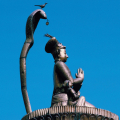DURBAR SQUARE
Durbar Square in Patan is probably the most beautiful complex of temples and palaces in all of Nepal. As in Kathmandu and Bhaktapur, temples and pagodas stand in front of the palace. The most remarkable of them is dedicated to Krishna, the avatar of Vishnu who is also the god of love. Apart from the classical Nepalese-style pagodas, made of brick and wood, you will notice a multi-storey stone temple that devotees can bypass through the open galleries.
To the north of the square and at the end of a street with a view of the mountains stands the temple of Bhimsen, protector of the merchants and supposedly possessing superhuman strength. Opposite and below is the Manga Hiti, a public fountain built in stone steps that has been flowing since the 6th century. Further south the Hindu temple of Vishwanath is a richly decorated two-storey pagoda. Note on the west side, the statue of the bull Nandi, the mount of Shiva.
In the centre, facing the palace, the bronze statue of a 17th century king stands on a stone column. Yoganarendra Malla, kneeling, looks out of his bedroom window where people continue to prepare their beds and bring food every day. He will remain immortal until the bird perched above his head has flown away. He owes this privilege to the powers of Taleju, the protector of the royal clan, who is worshipped in three shrines inside the palace. Degu Talle, a seven-storey tower built in 1640 by Siddhi Nara-singh Malla, faces the pillar. Note the huge bell suspended between two pillars.
The Royal Palace, built in the 14th century, has been extended several times over the centuries. Its symmetrical red brick façade is punctuated by carved wooden windows. The palace consists of a succession of temples separated by courtyards. The main gate is guarded by two stone lions and leads to the central courtyard, the Mul Chowk. Taleju Bhawani Mandir, a three-storey octagonal-shaped pagoda, overlooks Mul Chowk, an inner courtyard where there is also the family altar dedicated to the goddess, the saint of saints. Only royal priests can push the door, guarded by Ganga and Jamuna, two elegant bronze statues representing the sacred rivers and sketching a dance step on either side. On the other hand, at the far end of the palace, visitors can sometimes enter the intimacy of the Royal Bathroom at Sundari Chowk, another courtyard where a stone basin adorned with delicate statuettes is enthroned.
Did you know? This review was written by our professional authors.
Book the Best Activities with Get Your Guide
Members' reviews on DURBAR SQUARE
The ratings and reviews below reflect the subjective opinions of members and not the opinion of The Little Witty.
Find unique Stay Offers with our Partners






Le site à beaucoup souffert du tremblement de terre de 2015 et nombre d'édifices sont encore en cours de restauration et interdits au public.
Il me semble indispensable de prendre un guide ce qui augmente encore le tarif de la visite. Attention d'ailleurs aux faux guides